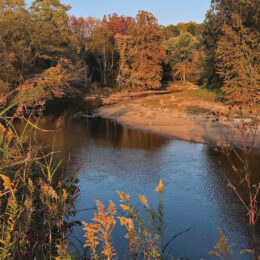by Jack Spaulding

The tiny Book Scorpion, Chelifer cancroides, is usually found among dusty old books where it preys on book lice and dust mites. It is one member of over 3,300 in the Pseudoscorpion family.
Recently, I got a call from Jason Knueven of the Batesville area. Jason is a grandson to Roman Nobbe, and like his grandfather, takes a great deal of interest in the outdoors. He had my undivided attention with the first words out of his mouth when he said, “I’ve got a scorpion I caught in my house … would you like to see it?”
I am no stranger to scorpions. I spent the summer following my high school graduation roaming the West with my Uncle Bob Bolton. In the desert country, there are scorpions. Uncle Bob was a mercantile salesman for the Henry Hillson Company; his territory was the Indian reservations in Colorado, Utah, New Mexico and Arizona.
I spent the summer and fall of 1968 seeing the last of the Old West, traveling with Uncle Bob to the various Indian reservation trading posts across the four states.
The most desolate location Uncle Bob called on was the trading post at Navajo Mountain. It was considered to be the most isolated place in the United States as it was 250 miles from the nearest post office. It was a long, full-day’s drive, one way on unmarked desert sand roads.
The trading post was run by Madelyn and her husband, Harvey, who were our hosts for our overnight stay. After supper, we would be sleeping in the old bunk house. I planned on draping my clothes over a chair to help keep out any pesky critters … especially scorpions. For sure, come morning, my duds and boots would be getting a good shaking before I put them back on!
During supper under the bright glow of an Aladdin kerosene light, I noticed something scurrying across the floor. As it got closer, I could see it was a scorpion the size of a half-grown crawdad headed right toward the kitchen table.
I jumped out of the chair, lunged, and, on the third step, mashed the poisonous varmint on the kitchen floor. I squashed it, and I squashed it good. Thinking I was to be praised for my quick actions, I was surprised to see everyone looking at me in disbelief and shocked silence.
Madelyn sternly said, “That scorpion wasn’t hurting anything! Who’s going to clean up that mess?”
As Uncle Bob was trying to stifle a snicker, I volunteered.
It had been 47 years since I had my last wild scorpion encounter, and I couldn’t wait to see what Jason had. I looked a little puzzled as he handed me a clear, plastic zipper lock bag and simply said, “It’s in there … it’s not very big.”
At first glance, the bag appeared to be empty. Then I saw a little crumb like object in the corner of the bag, and it moved!
Sure enough, I was looking at a prime example of Chelifer cancroides, or as commonly known, a “book scorpion.” It was smaller than the tip of a pencil eraser. It looked as if it would take three or more of the tiny rascals joining outstretched pinchers to reach from side-to-side across a Lincoln penny.
Unlike its much larger-sized, poisoned-tipped tailed cousins roaming the desert country, the book scorpion is known as a pseudoscorpion since it doesn’t have the upturned stinger tail. Its venom is delivered by its tiny pinchers.
It comes from a large family as there are 3,300 species of pseudoscorpions, and they are found all the way from Ontario and above the timberline in Wyoming to the Jenolan caves in Australia. They are found mainly in the tropics and subtropics. In short, they are almost everywhere.
The book scorpion is the species most commonly found in homes where they are often observed in rooms with dusty books. There the tiny animals find their food like booklice and house dust mites. To travel from place to place, they are ingenious, uninvited hitch hikers as they will cling to the underside of a larger flying insect like a beetle or a fly and “hitch a ride.” Most wind up in homes when they come in with the firewood.
Who said the library is a dull place?
Jack Spaulding is a state outdoors writer and a consumer of RushShelby Energy living along the Flatrock River in Moscow. Readers with questions or comments can write to him in care of Electric Consumer, P.O. Box 24517, Indianapolis, IN 46224; or email jackspaulding@hughes.net.



